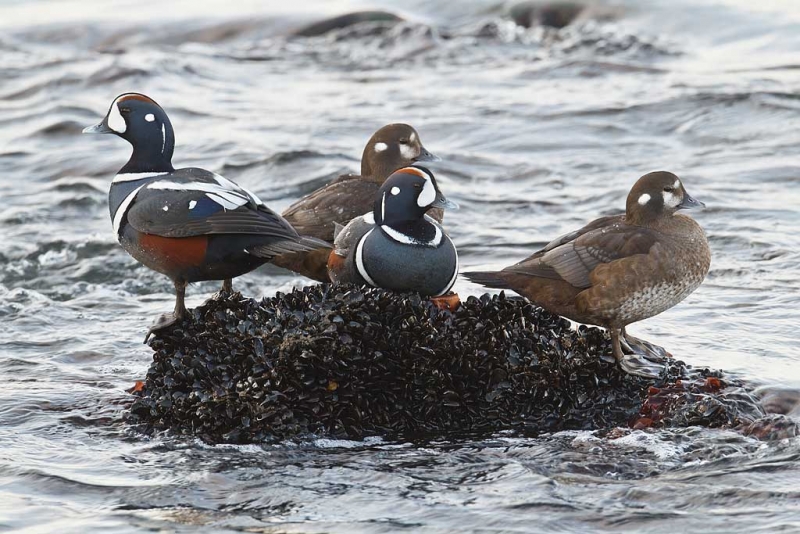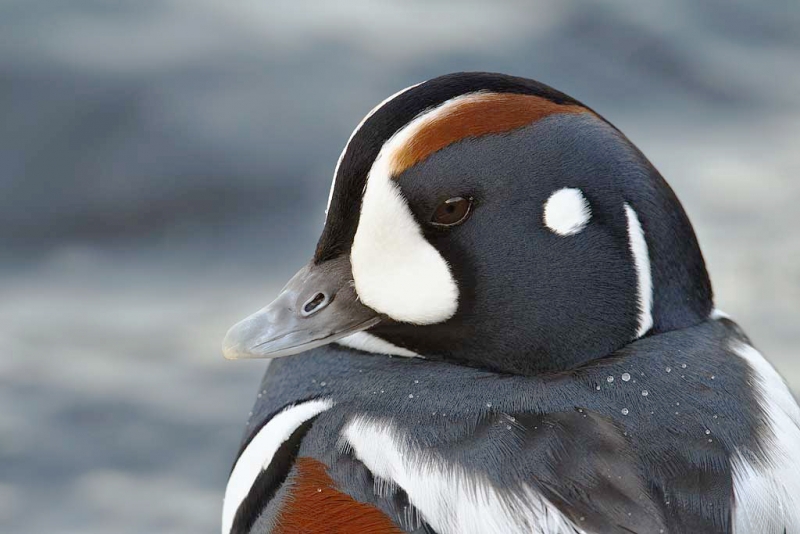|
Harlequin Ducks, two pair on the rocks. Barnegat Jetty, Barnegat Light, NJ. DEC 12, 2011. With the the tripod-mounted Canon 800mm f/5.6L IS lens and the EOS-1D Mark IV. ISO 400. Evaluative metering +1 stop (was still well underexposed): 1/25 sec. at f/18 in Av mode. 1/25 sec. is not a typo. Central Sensor Rear Focus/AI Servo AF and recompose. Click here if you missed the Rear Focus Tutorial. Lens/TC/camera body Micro-adjustment: +2. For a greater appreciation of the image, click on the photo. Then click on the enlarged version to close it. |
Just Duckie: Two Depth-of-field Questions
In the two images here you see two very different approaches. For the image above, I moved way back–sun angle was irrelevant as the birds were in the shade. For the image below I got low and used a few other professional tricks to get close enough to the group for a head portrait; this species can be quite skittish.
I write and teach: work wide open unless you can verbalize a reason for stopping down.
For the group image above, why f/18? (Wide open would have been f/5.6.)
For the head portrait below, why f/11? (Wide open with the TC would have been f/8.)
|
Harlequin Duck, drake head portrait. Barnegat Jetty, Barnegat Light, NJ. DEC 12, 2011. With the the tripod-mounted Canon 800mm f/5.6L IS lens, the 1.4X III TC, and the EOS-1D Mark IV. ISO 500. Evaluative metering -1 stop: 1/60 sec. at f/11 in Manual mode. Central Sensor (by necessity) Rear Focus/AI Servo AF active at the moment of exposure. Click here if you missed the Rear Focus Tutorial. Lens/TC/camera body Micro-adjustment: +4. For a greater appreciation of the image, click on the photo. Then click on the enlarged version to close it. |
Just Duckie: Additional Lessons
In view of the fact that I have long believed that the best way to teach is to ask, I continue:
For the group image why did I hold the shutter button down?
For the head portrait, why did I hold the shutter button down? Why was I actively focusing at the moment of exposure?
Why did I need to add light for the group image but subtract light for the head portrait? (The subjects and the backgrounds are the same….)
Barnegat Jetty Site Guide
Whenever I visit the Barnegat Jetty (which is every time that I come to Long Island in the winter), I follow Denise Ippolito’s excellent suggestions as detailed in her Barnegat Jetty Site Guide. Yesterday I was following Denise Ippolito and she was on the one who spotted the harlequins. Folks visit from many states and whether you are a local or are flying driving to New Jersey just to visit this famed locale, you will learn a ton of valuable lessons. My tips on getting really close to the Harlequins are included in the guide. See more great images and learn about the guide here.
artie is traveling 🙂
artie is traveling in the Southern Ocean (Falklands, South Georgia, & Antarctica) and will unable to respond to your questions and comments until after his return on 26 January 2012.
Shopper’s Guide
Below is a list of the gear used to create the images talked about in his blog post. Thanks a stack to all who have used the Shopper’s Guide links to purchase their gear as a thank you for all the free information that we bring you on the Blog and in the Bulletins. Before you purchase anything be sure to check out the advice in our Shopper’s Guide.
Canon 800mm f/5.L IS lens. Right now this is my all time favorite super-telephoto lens.
Canon 1.4X III Teleconverter. Designed to work best with the new Series II super-telephoto lenses.
Canon EOS-1D Mark IV professional digital camera body. My two Mark IVs are my workhorse digital camera bodies.
And from the BAA On-line Store:
LensCoats. I have a LensCoat on each of my big lenses to protect them from nicks and thus increase their re-sales value. All my big lens LensCoat stuff is in Hardwood Snow pattern.
LegCoat Tripod Leg Covers. I have four tripods active and each has a Hardwood Snow LegCoat on it to help prevent further damage to my tender shoulders 🙂
Gitzo GT3530LS Tripod. This one will last you a lifetime.
Mongoose M3.6 Tripod Head. Right now this is the best tripod head around for use with lenses that weigh less than 9 pounds. For heavier lenses, check out the Wimberley V2 head.
CR-80 Replacement Foot for Canon 800. When using the 800 on a Mongoose as I do, replacing the lens foot with this accessory lets the lens sit like a dog whether pointed up or down and prevents wind-blown spinning of your lens on breezy days by centering the lens directly over the tripod.
Double Bubble Level. You will find one in my camera’s hot shoe whenever I am not using flash.
Be sure to check out our camera body User’s Guides here.
The Lens Align Mark II. I use the Lens Align Mark II pretty much religiously to micro-adjust all of my gear an average of once a month and always before a major trip. Enjoy our free comprehensive tutorial here.
Canon EOS-1D Mark IV User’s Guide. Learn to use your Mark IV the way that I use mine. Also available for the 7D and the Mark III here.
















Nice shots, Art!
Why f/18 for the group? – because the close range ducks are not on the same focal plane. Stopping down is also extremely important (and challenging) for close range birds in flight.
Why f/11 for the portrait? – because of the close range, to bring out the fine texture in the feathers.
Why active focus? – no idea other than the obvious – to ensure perfect focus, especially of the eye which can move in the frame.
Addition of light for group? – to compensate for the shadow.
Subtraction of light for portrait – so the whites aren’t blown which will maintain texture in the white feathers.
Hi Rob, Thanks. Good on the d-o-f questions. Active focus is needed when the bird’s head is turning slowly as d-o-f at such close range is measured in small fractions of a single inch.
See below for a more detailed explanation of the exposure questions.
thanks for sharing and teaching
You are most welcome sir.
Hold shutter button down for group? With a slow shutter speed, a burst of shots gives a better chance of at least one of them happening while the camera is steady. It’s easy to move the rig a bit with that left hand during just one shot. There was also a better chance of catching all the birds holding still at some point in a burst
Hold shutter button down for head shot? Trying to catch the bird when holding still. Focusing at moment of exposure in case the bird moved. I’m sure your sharpness skills would be fine at 1/60. Not so sure about mine.
Added light for the group and subtracted for the head? The group has a lot of white in the background. Meter would have tried to make that gray. Head has a lot of dark in the middle and also background. Meter would have tried to lighten to gray which would have burned out the whites on the duck/s face.
Thanks for all the teachiing !!!
YAW Elinor. You are right-on with the exposure answer. When the camera sees dark, it wants to open up. When it sees light, it stops down.
For the group shot there were two reasons for keeping the pedal to the medal:
1-to ensure four good head angles. It is impossible to check on that visually for four or even three subjects.
2-With the waves in the background, each image in a series will have a different look; by creating multiple images you can select the most pleasing wave pattern especially with regards to the light and dark tones behind the birds’ heads.
With the head portrait I was–as you said–looking for a good head angle while the bird was still .
It’s a case of magnification, the closer you are the greater the magnification and the lesser the DOF. This applies regardless of lens if you use an 800 at a particular mag to give a given size in the frame and you take the same shot using say a 500mm to give the same size then the DOF would be the same. You have a group first off – small birds but a frame filling group so you need a good DOF hence the small aperture. The close up here the mag is relatively high so a wide aperture would not give sufficient DOF hence f11. Relatively speaking the magnification is greater on the group hence the need for the smaller aperture. This can be extenuated to macro subjects – a dragonfly for example will usually be taken at between f8 – f16 despite the fact it is small – the point is you go in close to get a relatively high mag hence the smaller aperture.
Hey Jon, You are pretty much on the right track. When working at very close range with a super-telephoto, as in the head portrait, depth-of-field is measured in small fractions of an inch so it is best to stop down at least one full stop. Two full stops is better if you can get away with it.
For the group image I wanted to be sure to have enough d-o-f to cover the hen in the back. The male in the middle is sharp and I cam close on the hen….